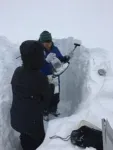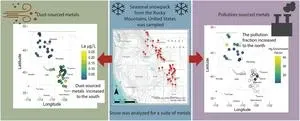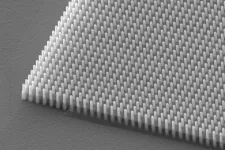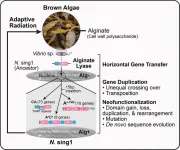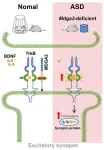(Press-News.org) Mountain snowpacks accumulate snow throughout the winter, building up stores of water that will supply communities across the American West throughout the long dry season. Now, a new study shows that as storms carry snow to the Rocky Mountains, they are also bringing mercury and other contaminants from mines in the region. The research helps scientists understand how contaminants are spread by atmospheric circulation and has implications for snowpack preservation and illuminating the lasting environmental impact of mining activities.
The study, published in the May issue of the journal Environmental Pollution, examined contamination levels for Mercury, Zinc, Cadmium and Antimony from nearly 50 sites in the Rocky Mountains. DRI’s Monica Arienzo, Associate Research Professor of Hydrology, led the research, along with colleagues from the U.S. Geological Survey (USGS), the University of Nevada, Reno, and Portland State University. They found higher levels of metal contaminants in the northern Rockies and identified mines in the Pacific Northwest, Idaho, and Montana as the likely source by following winter storms back in time. It is one of the first studies to look at metal contamination across the greater Rocky Mountains.
“Metal pollution in the Rockies is relatively understudied,” Arienzo said. “Other studies have focused on certain parts, so the fact that we have this transect from Montana to New Mexico makes this study unique.”
Although contamination levels were found to be within guidelines set by the EPA for both drinking water and aquatic life, dust can accelerate snowmelt by decreasing the reflectivity of the snowpack. The data can also provide critical information about how environmental contaminants and dust are distributed by the atmosphere.
The study combined a number of data sets to capture a comprehensive understanding of the amount of metal contamination making its way to the region. First, snow samples were collected from 48 sites throughout the Rocky Mountains during the spring of 2018. The researchers then measured metal concentrations in each sample, including metals like calcium that come from natural dust rather than human activities. By comparing the amounts of purely dust-sourced metals to those that result from both dust and industrial activities like mining, the scientists determined how much metal contamination stemmed from human activities.
To strengthen their findings, they then examined data from the National Atmospheric Deposition Program that measured mercury and calcium in precipitation from 2009 through 2018. Again, the scientists saw higher amounts of metal contamination in the northern Rockies, across Montana, Idaho, and Northern Wyoming.
“I was surprised by the amount of agreement we saw between all these different data sets we brought together,” Arienzo said. “The snow samples showed us that contamination is higher in the northern Rockies, and that was really interesting. Looking at mercury contamination over time helped us say that 2018 is not just a fluke. When you start to see these trends that are consistent between different records, it makes you feel more confident that something’s really happening here.”
To determine the likely source of the contaminants, Arienzo and her colleagues tracked the winter’s storms back through time. For the northern Rockies, many of the storms had moved in from the Pacific Northwest region, whereas in the southern stretch of the mountains, storms came from across the Mojave Desert.
By referencing a USGS dataset that tracks mining and smelting locations, the scientists identified active sites near the northern Rockies. An examination of EPA Superfund locations uncovered historical sites that could also be sources of contamination.
“Our idea is that the dust from current and historical mining sites gets carried up into the mountains and deposited across our study sites,” Arienzo said. “This study shows the importance of continued scientific monitoring efforts, like the long-term USGS datasets we used here, as well as mitigation of current and historical mining sites.”
The research is part of a larger study, supported by the National Science Foundation (NSF), using tree rings to examine historical mercury contamination. Arienzo and her team will compare the mercury record found in tree rings to that found in the snowpack to better understand how mercury is deposited and spread throughout the environment.
----------------
More information: The full study, Latitudinal gradients of snow contamination in the Rocky Mountains associated with anthropogenic sources, is available from Environmental Pollution at https://doi.org/10.1016/j.envpol.2025.126094
Study authors include: Monica Arienzo (DRI), Kelly Gleason (Portland State U.), Graham Sexstone (USGS), Mae Gustin (UNR), Melissa Schwan (UNR), Nicole Choma (UNR), Sarrah Dunham-Cheatham (UNR), Joe McConnell (DRI), Peter Weisberg (UNR), and Adam Csank (UNR)
About DRI
We are Nevada’s non-profit research institute, founded in 1959 to empower experts to focus on science that matters. We work with communities across the state — and the world — to address their most pressing scientific questions. We’re proud that our scientists continuously produce solutions that better human and environmental health.
Scientists at DRI are encouraged to follow their research interests across the traditional boundaries of scientific fields, collaborating across DRI and with scientists worldwide. All faculty support their own research through grants, bringing in nearly $5 to the Nevada economy for every $1 of state funds received. With more than 600 scientists, engineers, students, and staff across our Reno and Las Vegas campuses, we conducted more than $52 million in sponsored research focused on improving peoples’ lives in 2024 alone.
At DRI, science isn’t merely academic — it’s the key to future-proofing our communities and building a better world. For more information, please visit www.dri.edu.
END
New study finds Rocky Mountain snow contamination
An examination of Rocky Mountain snow finds higher contamination levels of mercury and others metals in the northern part of the range, consistent with increased current and historical mining in the region
2025-04-01
ELSE PRESS RELEASES FROM THIS DATE:
Study examines lactation in critically ill patients
2025-04-01
It can happen in an instant – a mother experiences a medical emergency during delivery that requires intensive care.
Meanwhile, her newborn infant is sent to the neonatal intensive care unit.
This early separation can greatly disrupt the establishment of adequate milk supply for those who want to breastfeed.
Recent research from the University of Michigan reveals that simple awareness on the part of the care team can help protect the breastfeeding relationship for patients in the ICU.
The work was spearheaded by Kayla Kolbe, M.D., clinical assistant ...
UVA Engineering Dean Jennifer West earns AIMBE’s 2025 Pierre Galletti Award
2025-04-01
Jennifer L. West, Dean of the University of Virginia’s School of Engineering and Applied Science and the Saunders Family Professor of Engineering, has been awarded the 2025 Pierre Galletti Award, the highest honor from the American Institute for Medical and Biological Engineering (AIMBE).
West is recognized for her “innovative research in biomaterials and nanomedicine, her leadership in the field, and her dedication to mentoring the next generation of biomedical engineers.” The Galletti Award is named after AIMBE’s founding member and past president and recognizes a career-long commitment to advancing the field ...
Doubling down on metasurfaces
2025-04-01
Almost a decade ago, Harvard engineers unveiled the world’s first visible-spectrum metasurfaces – ultra-thin, flat devices patterned with nanoscale structures that could precisely control the behavior of light. A powerful alternative to traditional, bulky optical components, metasurfaces today enable compact, lightweight, multifunctional applications ranging from imaging systems and augmented reality to spectroscopy and communications.
Now, researchers in the Harvard John A. Paulson School of Engineering and Applied Sciences (SEAS) are doubling down, literally, on metasurface technology ...
New Cedars-Sinai study shows how specialized diet can improve gut disorders
2025-04-01
A new study from Cedars-Sinai examined whether a specialized diet could improve symptoms of gastrointestinal disorders linked to an imbalance in gut microbiota.
The research tested the elemental diet’s effectiveness and explored whether improving its unappealing taste— a major barrier—could help patients adhere to the diet’s stringent protocol. The investigators’ findings were published in the peer-reviewed journal Clinical Gastroenterology and Hepatology.
The elemental diet is a special low-fat liquid formulation ...
Making moves and hitting the breaks: Owl journeys surprise researchers in western Montana
2025-04-01
Researchers tracked 89 Northern Saw Whet Owls (Aegolius acadicus) along a migration corridor in Western Montana, underscoring the efficacy of telemetry studies for detailed investigations into the movements of birds. Their paper, “Migration and Roosting Behavior of Northern Saw-whet Owls (Aegolius acadicus) During Fall Migration in Western Montana,” was published in the Journal of Raptor Research. The research team was surprised to discover that owls demonstrated stopover behavior, meaning pauses along migration for resting and refueling, as well as notable individual ...
PKU Scientists simulate the origin and evolution of the North Atlantic Oscillation
2025-04-01
Peking University, March 31, 2025: A simulation on the origin and evolution of North Atlantic Oscillation (NAO) has been conducted by a PKU research team led by Nie Ji, Associate Professor of School of Physics, and Hu Yongyun, Dean of Institute of Ocean Research, along with a research team from National Natural Science Foundation of China. Their study, recently published in Nature Communications, reveals the coherent relationship between NAO and the evolution of continents, mountains and oceans.
Why It Matters:
NAO plays a critical role in shaping climate patterns, affecting temperature, precipitation, and storms across regions like Europe, China, ...
ICRAFT breakthrough: Unlocking A20’s dual role in cancer immunotherapy
2025-04-01
Peking University, March 31, 2025: Professor Zeng Zexian’s team from the Center for Quantitative Biology at the Peking University Academy for Advanced Interdisciplinary Studies, in collaboration with the Peking University-Tsinghua University Joint Center for Life Sciences, has developed ICRAFT, an innovative computational platform for identifying cancer immunotherapy targets. Their study has been published in Immunity, an immunology research journal.
Why It Matters:
·There is an urgent need for precision immunotherapy strategies that simultaneously target both ...
How VR technology is changing the game for Alzheimer’s disease
2025-04-01
BOSTON - April 1, 2025 - Most people donning virtual reality (VR) goggles are seeking the thrill of being immersed in a fictitious video game world. But some are donning them for an entirely different experience: to help researchers identify those most at risk of developing Alzheimer’s disease.
“We know that early detection of Alzheimer’s disease and other dementias can have a significant impact on the quality of life of the affected persons, through deployment of lifestyle changes and medications ...
A borrowed bacterial gene allowed some marine diatoms to live on a seaweed diet
2025-04-01
A group of diatom species belonging to the Nitzschia genus, gave up on photosynthesis and now get their carbon straight from their environment, thanks to a bacterial gene picked up by an ancestor. Gregory Jedd of Temasek Life Sciences Laboratory, Singapore, and colleagues report these findings in a new study published April 1st in the open-access journal PLOS Biology.
Unlike most diatoms, which perform photosynthesis to generate carbon compounds, some members of the genus Nitzschia have no chlorophyll and instead ...
Balance between two competing nerve proteins deters symptoms of autism in mice
2025-04-01
In mice, autism symptoms arise when a certain pair of competing nerve proteins falls out of equilibrium, according to a study published April 1st in the open-access journal PLOS Biology by Dongdong Zhao of Wenzhou Medical University, China, Yun-wu Zhang of Xiamen University, China, and colleagues.
Approximately 1% of the world population is considered to have Autism Spectrum Disorder (ASD), exhibiting a series of social and cognitive symptoms. Previous research has linked certain genetic factors to ASD, including many associated ...
LAST 30 PRESS RELEASES:
Norbert Holtkamp appointed director of Fermi National Accelerator Laboratory
New agentic AI platform accelerates advanced optics design
Biologists discover neurons use physical signals — not electricity — to stabilize communication
Researchers discover that a hormone can access the brain by hitchhiking
University of Oklahoma researcher awarded funding to pursue AI-powered material design
Exploring how the visual system recovers following injury
Support for parents with infants at pediatric check-ups leads to better reading and math skills in elementary school
Kids’ behavioral health is a growing share of family health costs
Day & night: Cancer disrupts the brain’s natural rhythm
COVID-19 vaccination significantly reduces risk to pregnant women and baby
The role of vaccination in maternal and perinatal outcomes associated with COVID-19 in pregnancy
Mayo Clinic smartwatch system helps parents shorten and defuse children's severe tantrums early
Behavioral health spending spikes to 40% of all children’s health expenditures, nearly doubling in a decade
Digital cognitive behavioral treatment for generalized anxiety disorder
Expenditures for pediatric behavioral health care over time and estimated family financial burden
Air conditioning in nursing homes and mortality during extreme heat
The Alps to lose a record number of glaciers in the next decade
What makes a good proton conductor?
New science reporting guide published for journalists in Bulgaria
New international study reveals major survival gaps among children with cancer
New science reporting guide published for journalists in Turkey
Scientists develop a smarter mRNA therapy that knows which cells to target
Neuroanatomy-informed brain–machine hybrid intelligence for robust acoustic target detection
Eight SwRI hydrogen projects funded by ENERGYWERX
The Lundquist Institute and its start-up company Vitalex Biosciences Announces Strategic Advancement of Second-Generation fungal Vaccine VXV-01 through Phase 1 Trials under $40 Million Competitive Con
Fine particles in pollution are associated with early signs of autoimmune disease
Review article | Towards a Global Ground-Based Earth Observatory (GGBEO): Leveraging existing systems and networks
Penn and UMich create world’s smallest programmable, autonomous robots
Cleveland researchers launch first major study to address ‘hidden performance killer’ in athletes
To connect across politics, try saying what you oppose
[Press-News.org] New study finds Rocky Mountain snow contaminationAn examination of Rocky Mountain snow finds higher contamination levels of mercury and others metals in the northern part of the range, consistent with increased current and historical mining in the region

